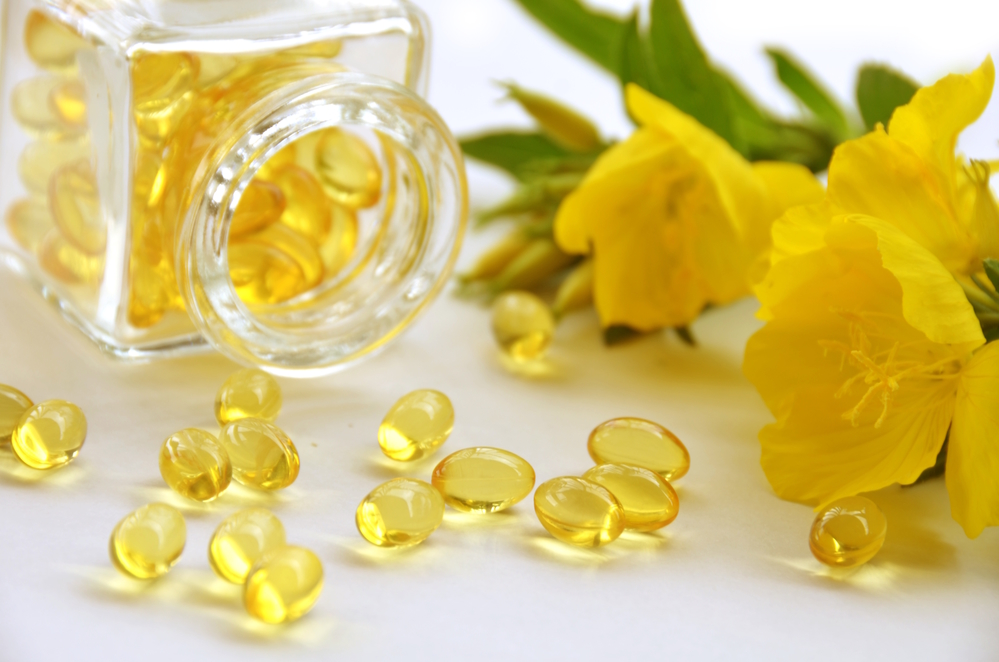Gamma-linolenic acid (GLA) is an omega-6 fatty acid that is a precursor to prostaglandin, a compound that is synthesized at the site of an infection or injury to mediate inflammation, fight cell damage, and regulate pain as part of the healing process.
GLA has been touted for a variety of uses, from rheumatoid arthritis (RA) to diabetic neuropathy and beyond. In addition to preventing or treating certain diseases and conditions like these, some say that GLA can work as a complement to other drugs to help alleviate symptoms.
Hemp seed oil, evening primrose oil, borage seed oil, and blackcurrant oil are among some of the highest sources of GLA. Available as a dietary supplement, GLA can also be found in significant quantities in oats, barley, spirulina, and hemp seeds.
What Is Gamma-Linolenic Acid Used For?
Practitioners of alternative medicine believe that gamma-linolenic acid can improve overall health by reducing the level of inflammatory proteins, known as cytokines, in the body. Cytokines are essential to triggering inflammation, a natural immune response used to neutralize infections and heal injuries.
However, if cytokine levels persist—as can happen with obesity, high blood pressure, autoimmune diseases, and other chronic disorders—the unrelenting inflammation can cause progressive damage to cells and tissues.
In alternative medicine, GLA is believed to prevent or treat a wide range of unrelated health conditions, including:
- Asthma
- Atherosclerosis
- Cancer
- Diabetic neuropathy
- Eczema
- Chronic fatigue syndrome
- Depression
- High cholesterol
- Menopause symptoms
- Metabolic syndrome
- Psoriasis
- Rheumatoid arthritis
Few of these claims are strongly supported by research. Furthermore, most of the current research involves the use of primrose oil or borage oil rather than GLA supplements. With that being said, there have been some promising findings. Here is some of what the current research says.
Arthritis
It turns out the ancient healers were on to something: GLA can help to decrease inflammation. Some studies show that it can improve your symptoms and functionality, and that the risk of side effects is low.
If you have arthritis, talk to your doctor about adding a supplement to your diet to help manage your symptoms. There are several studies to support the use of ensuring adequate intake of GLA.
Eczema
Eczema is an umbrella term used to describe a group of skin conditions that occur in episodes and cause itching, redness, bumps, and scaling. Atopic dermatitis is one of the more common forms of eczema, alongside contact dermatitis and seborrheic dermatitis.
According to a 2014 study, a 4- to 6-gram (g) dose of evening primrose oil taken daily decreased the severity and recurrence of atopic dermatitis in 21 adults after 12 weeks of use.
Higher doses conferred better results, with 6 g of primrose oil delivering no less than 480 milligrams (mg) of GLA per day. While promising, the conclusions were somewhat limited by the lack of a matched set of participants provided a placebo. Further research is needed.
Rheumatoid Arthritis
RA is an autoimmune form of arthritis characterized by persistent inflammation and the progressive damage of joints and other tissues. It is believed that, by tempering the underlying autoimmune inflammation, GLA may reduce the progression or severity of the disease.
According to the 2014 study, the daily use of borage oil (on its own or with fish oil) reduced the need for disease-modifying antirheumatic drugs (DMARDs) commonly used to treat rheumatoid arthritis.
The 18-month trial involved 150 adults with rheumatoid arthritis who were assigned a daily dose of either borage oil capsules (corresponding to 1.8 g of GLA), fish oil capsules, or both. At the end of the study period, all three groups responded positively to therapy, with marked reductions in both disease activity and DMARD use.
Premenstrual Syndrome
Many women around the world take evening primrose oil to relieve symptoms of premenstrual syndrome (PMS). However, there’s no conclusive scientific evidence that it works.
Most studies have shown a lack of benefits, some people still believe it’s an effective treatment option. If you want to try evening primrose oil or other GLA supplements to treat PMS, it’s always best to talk to your doctor first.
Diabetic Neuropathy
Diabetic neuropathy is a nerve disorder characterized by painful pins-and-needles sensations. The condition is caused by the persistent inflammation associated with diabetes which gradually wears away the outer insulating membrane of nerve cells called the myelin sheath.
Some research done on rats suggests that GLA may help treat this condition. Older studies have found that GLA may also help treat diabetic neuropathy. This is a type of nerve damage that causes tingling and discomfort in the extremities and often affects people with diabetes.
Further investigation is necessary to determine if GLA can be beneficial in treating this illness and other frequent issues linked to diabetes. Research in 2007 revealed that mice with chemically-induced diabetes had improved nerve function (including nerve signal speed and blood supply to nerve cells) when taking GLA for a period of eight weeks, as compared to mice who were given docosahexaenoic acid, which is found in fish oil.
Fish oil is a popular additional treatment for individuals with early-stage diabetic nerve damage. Interestingly, lower doses of GLA corresponded to better results. If the experiment proves successful in humans, GLA could be a potential solution for avoiding the neurological condition that affects a quarter of individuals with type 2 diabetes.
Menopause
Borage oil and primrose oil have both been used for centuries to treat menopause symptoms. There is some evidence, albeit slight, of such benefits. According to a 2013 study, female rats that had their ovaries removed experienced vaginal cornfication after receiving GLA supplements for 21 days.
Vaginal cornification occurs when rising levels of estrogen cause surface cells to become larger and flatter as part of the menstrual cycle. This indicates that GLA has estrogen-like effects and suggests that GLA supplements may alleviate symptoms of menopause by overcoming low estrogen levels.
Further research is needed to establish whether the same dose used in rats—10 milligrams per kilogram (mg/kg) per day—might trigger the same effect in menopausal women. (For a 100-pound woman, that would translate to roughly 550 mg per day.)
Possible Side Effects
GLA supplements are well-tolerated by most people, but they can cause side effects. These side effects are usually mild. They include symptoms such as headaches, loose stools, and nausea.
Don’t take GLA if you have a seizure disorder. You should also avoid taking GLA if you’re going to have surgery soon or if you’re pregnant. GLA supplements can also interact with certain drugs, including warfarin.
Gamma-linolenic acid is generally considered safe for use. Common side effects, which can particularly occur when first starting treatment, include:
- Belching
- Flatulence
- Soft stools
- Diarrhea
Symptoms tend to be mild and gradually resolve on their own as the body adapts to treatment. Persistent symptoms can usually be relieved by reducing the dose.
That said, you should avoid GLA if you have pre-existing diarrhea or any condition characterized by chronic diarrhea, such as diarrhea-predominant irritable bowel syndrome (IBS-D).
The safety of GLA in babies and younger children has not been established. As such, it is best to avoid GLA while breastfeeding or in children under 7. Due to its estrogen-like effects, GLA supplements should be avoided during pregnancy as they may increase the risk of miscarriage.
Furthermore, avoid any GLA supplement containing borage oil if you are trying to get pregnant. Borage oil contains pyrrolizidine alkaloids that are contraindicated in pregnancy due to the risk of birth defects.
Interactions
Gamma-linolenic acid is known to slow blood clotting and may amplify the effects of blood thinners such as Coumadin (warfarin) and Plavix (clopidogrel), causing easy bruising and bleeding. Whether you take these drugs or not, stop taking GLA supplements at least two weeks before a scheduled surgery to avoid excessive bleeding.
Taking GLA with phenothiazines used to treat schizophrenia and bipolar disorder may cause spontaneous seizures. Avoid GLA if you are taking Mellaril (thioridazine), Prolixin (fluphenazine), Stelazine (trifluoperazine), Thorazine (chlorpromazine), or any other phenothiazine-class antipsychotic.
If you are interested in taking GLA supplements for a specific health concern, let your healthcare provider know so that you can be monitored for side effects or interactions. Doing so also allows you to discuss other treatments that may be more appropriate for you as an individual.
Always advise your healthcare provider about any medications or other supplements you are taking, whether they are prescription, over-the-counter, nutritional, herbal, or recreational.
Dietary GLA: Where To Find It
Wondering if you need to add some GLA to your life? While the only real way to determine your GLA status is through fatty acid panel testing, research tells us that specific individual factors can make an individual more susceptible to low GLA-status. These factors include age, diet, genetic variations, cigarette smoking, alcohol consumption, and stress.
If any of these factors apply to you (or if you just want to give your cells a little extra love) you may want to consider upping your GLA game with a dietary supplement. GLA can be found in relatively high abundance in the plant seed oils of borage, black currant, and evening primrose.
Out of these primary sources, borage oil contains the highest amount of naturally occurring GLA, and is often used for dietary supplementation. There are no established guidelines or recommendations for GLA usage; however, doses as small as 200 mg/day to as large as 3 g/day have shown to be safe, effective, and well tolerated.
As with any dietary supplement, you should speak with your doctor or nutritionist about what dose of GLA would best fit your individual health needs before starting a GLA regimen.
[aad_coconut_oil]
What to Look For
Dietary supplements are not strictly regulated in the United States, making it hard to know which brands are good and which fall short. To better ensure quality and safety, opt for brands that have been voluntarily submitted for testing by an independent certifying body.
Buying GLA supplements can often be confusing since the milligrams listed on the product label do not always correspond to the amount of GLA in the supplement.
For example, a product labeled “borage oil concentration GLA 1,000 mg” doesn’t necessarily mean that there are 1,000 milligrams of GLA in each capsule. Check the ingredient label; more often than not, it means that there are 1,000 milligrams of borage oil corresponding to around 240 mg of GLA.
Always read the ingredient panel to ascertain how much GLA is delivered per capsule in milligrams—not percentages. If you are strictly vegetarian or vegan, check that the gelcap is made with a vegetable-based gelatin rather than one derived from beef or pork cartilage.
Most GLA supplements can be stored safely at room temperature or in the refrigerator. Keep the supplements away from direct sunlight, which can oxidize the fatty acids, and dispose of any gelcaps that are leaking or misshapen. Never use a supplement after its expiration date.
Dosage and Preparation
Most GLA supplements are available as soft gelatin capsules with doses ranging from 240 to 300 mg per capsule. There are no universal guidelines for the appropriate use of gamma-linolenic acid. Dosages of up to 1,800 mg have been used with few notable side effects for up to 18 months in adults.
It should not be assumed that everyone needs such high doses of GLA or that lower doses are any less effective. As a rule of thumb, start with the lowest possible dose and increase gradually week-on-week as tolerated. It is best to consult a pediatrician for a recommended dose for children.
Takeaway
Gamma linolenic acid (GLA) is an omega-6 fatty acid. It’s most commonly found in the seeds of the evening primrose. It’s been used for centuries in homeopathic remedies and folk cures. Native Americans used it to reduce swelling, and by the time it made its way to Europe, it was used to treat almost everything. It was eventually nicknamed the “king’s cure-all.”
Many of the purported benefits of GLA haven’t been supported by the most up-to-date research. But some studies suggest it may help treat certain conditions.









